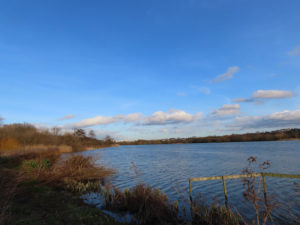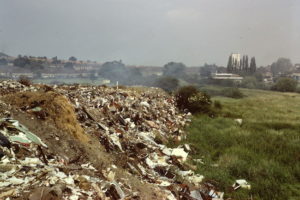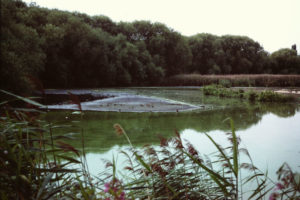A mild October finds Ben Watt — and Brent Reservoir — in a state of limbo.

October. The weather is too mild. The seasons blur. I stand on the old landfill dump high above the north marsh at Brent Reservoir (Welsh Harp) — now a mature scrubland good for skywatching and stonechats — and wait for birds that signal change and the coming of winter. I am too hot in my coat — I take it off. It starts to rain — I put it back on. The clouds part — I’m hot again. What looks like a promising brambling turns out to be a chaffinch. A coach-load of migrating wood pigeons pass over. Then another. I want siskins and redwing and lesser redpoll — birds of frosty birches and berries — but the sky goes back to being sullen and mostly empty.
In this state of limbo, it strikes me the trouble with campaigning — especially if you give it a public face on social media — is that people also start to expect markers of change, regular peppy updates with good news and exclamation marks. You can only do the righteous anger and the photos of debris-strewn marshes so many times, before it all starts to sound a bit earnest and solemn. And social media doesn’t really do solemn or samey; it can get outraged on your behalf but only for so long. It means our social media profile has gone a bit quiet, and our campaign group meetings have become more intermittent. Incremental change doesn’t make great headlines. And it is making me feel edgy.

The dump before it was flattened and restored, 1990s. Photo: Leo Batten
In the absence of major works this winter, my co-campaigner Leo drives over and the two of us meet Canal and River Trust’s local volunteer leader to discuss possible manageable winter jobs for whoever we can rope in for free, under supervision. We battle our way to the smaller of the two bird hides on the east marsh. Back in the nineties, it stood neatly on the edge of a recently-restored reed bed, overlooking a small bay and shingle island, with Brent Peninsula across the water and the expanse of the main reservoir stretching away to Wembley Stadium to the west. Flowering rush grew at the water margin. Waders and heron put on a show. Today brambles and balsam clog the path to the door, and in spite of major expensive tree-thinning works in February, nature has wasted no time in filling the space again. Willow stumps have sprouted. Reed has grown thick. The sightlines from the hide have vanished. It underlines how much stewardship and regular management must be part of any plan.

Brent Peninsula from the heron hide, 1990s. Photo: Leo Batten
‘Fear not,’ says CRT’s volunteer leader. ‘A machete and brush cutter is all you need. I shall cut a trapezium out of the vegetation and the view will be back’. A TRAPEZIUM! Sounds scientific. ‘Not really,’ he says, ‘but it’ll keep you going for a bit.’ How many volunteers will you need, I ask. ‘I’ll do it myself if I have to. I love this kind of job,’ he says smiling broadly. And for a moment it feels like Christmas is saved. And I feel less edgy. And the campaign has wheels again.
Mid-month I meet with Canal and River Trust to discuss the state of the wider picture. My heart sinks to learn the local environment manager is leaving. He has been instrumental in helping turn our campaigning into actual action over the past year and a half; someone who saw the potential in Brent Reservoir and wanted to really help. He has also been the one driving through the publication of the new ‘vision’ – a blueprint for a major overhaul of the reservoir, for which our campaign group has provided crucial input. He tells me all three owners have at last agreed to the final document and it is now with the GLA for rubber-stamping. ‘Getting it over the line before I leave is very important to me,’ he says. I feel a bit emotional. If it weren’t a Zoom meeting I’d have been minded to get up and give him a hug.
I think back over the Welsh Harp’s history — a shallow natural valley near Kingsbury flooded two hundred years ago to provide water for London’s canal network; its wild popularity with Victorian daytrippers; the fairs and regattas, the horseracing and pleasure gardens; the sailing and the speedboat championships of the 1930s (one of them opened by aviator Amy Johnson); Neasden Public Library building a reading terrace overlooking the water. Churchill allegedly kept a secret wartime seaplane permanently on standby on the southern shore. And I think of its growing post-war role as a bird sanctuary, resulting in its SSSI citation in 1950 — almost the first in the UK — and the glorious urban wetlands restoration project of the late 1980s of which Leo was so much a part.
I think of where I came in last year and wonder if the Welsh Harp’s time could come again, if the new ‘vision’ could become a reality and — unlike every other worthy restoration document produced on the reservoir’s behalf in recent years — really attract major third-party funding and bring transformative change.
I’d love to say at this point a flock of arriving winter birds flew over on cue, and my wait was over, but they didn’t. I kept watching though.
*
Ben Watt is a musician and writer, best known as one half of Everything But The Girl. His memoir ‘Romany and Tom’, about his parents, was nominated for the Samuel Johnson (Baillie Gifford) Prize. He runs Buzzin’ Fly Records, and in 2021 founded environmental pressure group Cool Oak.